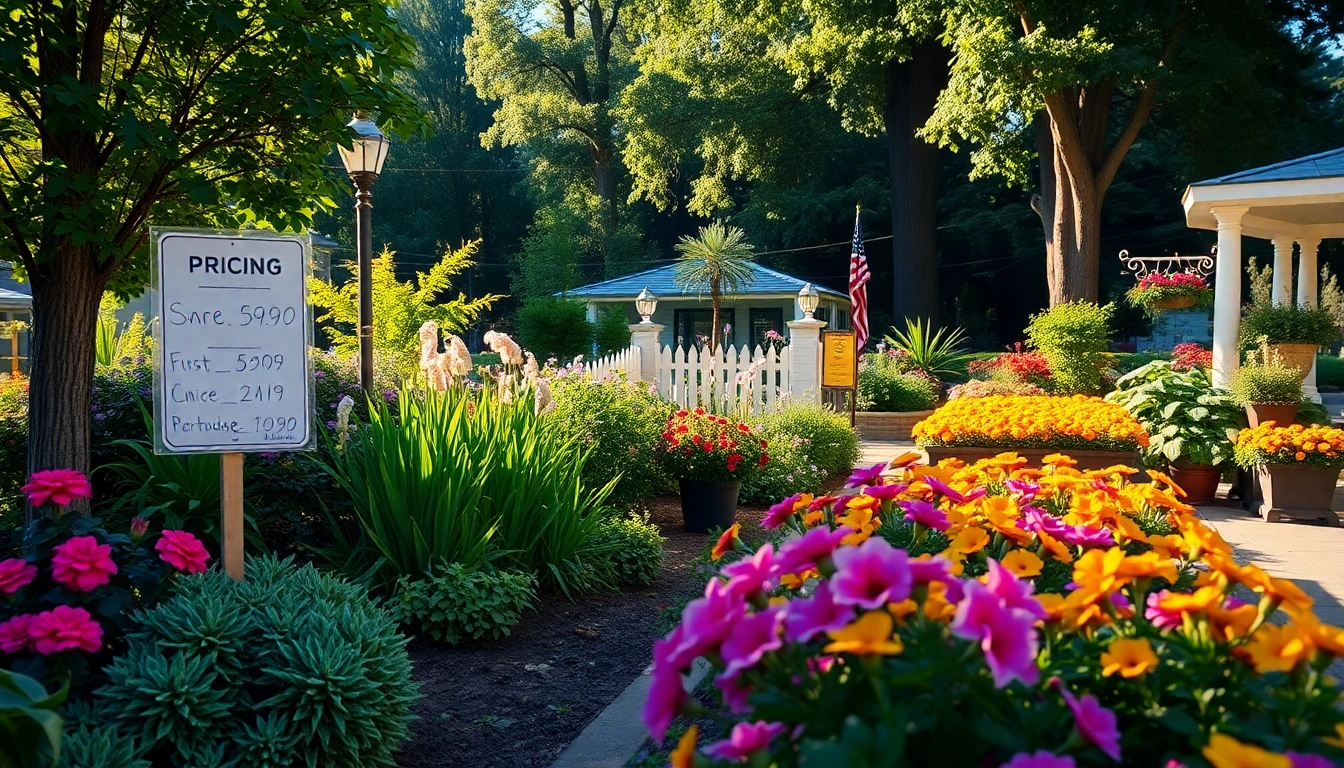
Comprehensive Landscaping Company Pricing: Understanding Costs for Your Dream Garden
Understanding Landscaping Company Pricing
Landscaping can transform any outdoor space, from residential backyards to commercial properties, enhancing aesthetics and usability. However, one of the most common queries prospective clients have is about the landscaping company pricing. Understanding how these prices are determined can help you budget effectively and choose the right service for your needs.
Factors Influencing Pricing
Several factors contribute to the pricing of landscaping services, making it essential for consumers to understand what they are paying for. Below are the primary elements influencing landscaping costs:
- Project Complexity: The intricacy of the design and the scope of work considerably impact overall costs. Simple lawn maintenance will generally cost less than a complete renovation that includes grading, detailed planting schemes, and hardscaping.
- Materials Used: The choice of materials, such as plants, soil, mulch, and hardscape elements like stone and pavers, affects the budget. Premium materials will increase costs but often yield better long-term results.
- Labor: Labor costs vary significantly based on geographic location, skill level of the workers, and the duration of the project. Higher wages in urban areas typically lead to increased service fees.
- Seasonality: Landscaping prices may fluctuate throughout the year, with peak seasons typically seeing higher rates due to increased demand. Planning your project during off-peak times can save money.
- Additional Services: Extra services such as irrigation installation, ongoing maintenance, or pest control can add to the overall pricing and should be considered when budgeting.
Common Pricing Models
Landscaping companies often use different pricing models, which can affect how customers view their costs. The most prevalent models include:
- Per Square Foot: Many landscaping services charge based on the square footage of the area to be landscaped. This model is beneficial for clients with specific dimensions, leading to transparent pricing.
- Project-Based Pricing: For more extensive or complex projects, a flat project fee may be determined upfront. This model allows both the client and the company to agree on costs before any work begins.
- Hourly Rates: Some landscaping companies charge by the hour, which can vary based on skill level and experience. This model may be more suitable for smaller tasks or maintenance work.
- Package Deals: Certain companies offer bundled services for a fixed price, such as seasonal clean-ups, maintenance, or design and installation. These packages can be more cost-effective for clients seeking comprehensive care.
Average Costs in Different Regions
Landscaping costs can vary dramatically depending on geographic location. Here’s a breakdown of average costs observed in different regions of the United States:
- Northeast: In states like New York and Massachusetts, average landscaping costs range from $4,000 to $10,000 for comprehensive projects, including planting and hardscaping.
- South: In states like Florida and Texas, landscaping prices tend to be lower due to milder climates, commonly falling between $3,000 to $8,000.
- Midwest: Regions like Illinois and Ohio may see average prices from $4,000 to $9,000 depending on the project’s scope, especially during peak seasons.
- West: In California, landscaping projects can be on the higher end, with costs averaging $5,000 to $12,000, driven by labor costs and diverse ecosystems.
Comparison of Landscaping Services
When considering landscaping services, it’s vital to distinguish between residential and commercial landscaping needs, as the pricing often reflects the nature and scale of the project.
Residential vs. Commercial Landscaping Pricing
Residential landscaping typically focuses on personal aesthetic preferences and enhancing curb appeal, while commercial landscaping often emphasizes functionality and professional appearance. Here’s a deeper look into how pricing differs between these two categories:
- Residential Landscaping: These projects usually involve design, planting, and maintenance tailored to homeowners and generally cost between $2,000 to $10,000, depending on the project scale.
- Commercial Landscaping: For businesses and public spaces, projects can be more extensive and are often designed to attract customers or enhance safety, with costs typically ranging from $8,000 to $25,000.
- Maintenance Services: Maintenance for residential yards may be charged hourly or through a service plan, while commercial properties are often under contract agreements for regular upkeep to maintain their pristine appearance.
Factors Affecting Service Costs
Several components impact service costs in landscaping, continually influencing how companies price their services:
- Job Size: The more extensive the project, the higher the cost due to increased labor and material requirements.
- Design Complexity: Intricate designs with various elements, including water features and unique plantings, will increase costs.
- Site Conditions: Existing site conditions such as poor soil quality, uneven terrain, or restricted access can complicate projects and elevate prices.
- Client Expectations: Custom requests or special requirements may lead to higher costs if they deviate from standard practices.
What to Look for in Estimates
When seeking estimates, it’s crucial to compare multiple companies and understand what is included in each proposal. Here’s what you should look for:
- Detailed Breakdown: A comprehensive estimate should include a breakdown of materials, labor, permits, and any additional costs.
- Timelines: Understanding the projected timeline is vital, as delayed projects can lead to unexpected costs.
- Warranties: Look for information regarding warranties or guarantees on both plants and workmanship.
- References: Seeking past client references can provide insights into a company’s reliability and quality of work.
Value for Investment in Landscaping
Investing in landscaping can yield significant returns beyond just aesthetic improvements. Whether it’s personal enjoyment of your home or an increased value for your business, here are some factors that highlight the long-term value of professional landscaping.
Long-Term Benefits of Professional Landscaping
Professional landscaping provides various long-term benefits, including:
- Aesthetic Appeal: Well-maintained landscapes enhance beauty and charm, positively influencing first impressions.
- Increased Usable Space: Properly designed outdoor areas can become extensions of living and working spaces.
- Environmental Benefits: Professional landscaping can contribute to environmental goals, such as reducing erosion and improving air quality.
- Functional Health: Thoughtfully designed landscapes can support outdoor activities, improve mental health, and create spaces for social gatherings.
Budgeting for Upgrades and Maintenance
Regardless of the initial investment in landscaping, ongoing maintenance ensures the longevity of your investment. Consider the following when budgeting:
- Regular Maintenance: Budget for upkeep such as mowing, pruning, and seasonal cleanups to maintain the property’s ambiance.
- Upgrades: Factors such as plant health, pest problems, or changing design trends may prompt additional investments over time.
- Seasonal Preparations: Invest in winter preparations such as snow removal and fall clean-ups to protect your landscape.
Enhancing Property Value Through Landscaping
Well-planned landscaping can significantly increase property values. Research suggests that landscaping can yield a return on investment of 100% to 200%:
- Curb Appeal: An attractive façade draws potential buyers, making properties more appealing in the market.
- Energy Efficiency: Strategic planting can lower energy costs by providing shade and privacy, factors that buyers often consider valuable.
- Functional Spaces: Landscapes that offer outdoor living areas or gardens are often favored by homebuyers.
Common Myths About Landscaping Pricing
Misconceptions around landscaping costs can lead to misunderstandings and unanticipated expenses. Dispel these common myths to foster better communication with landscaping companies.
Misconceptions that Can Cost You
Here are some widespread misconceptions about landscaping pricing:
- DIY is Always Cheaper: While DIY options may seem cheaper at first, costs can escalate if mistakes are made during the project.
- All Companies Charge the Same Rates: Prices can vary widely among landscaping companies based on services and quality levels.
- Seasonal Discounts Aren’t Worth It: Many companies offer discounts during off-peak seasons, which can provide significant savings.
Clarifying Average vs. Premium Pricing
Understanding the distinction between average services and premium offerings is crucial. Here are some points to keep in mind:
- Quality of Work: Premium services typically involve highly skilled labor and superior materials, which justify higher costs.
- Design Services: Companies providing custom design and planning services often charge higher rates for their expertise.
- Client Satisfaction: Companies with strong reputations often charge more but can guarantee greater satisfaction through proven results.
Understanding Additional Costs and Hidden Fees
Landscaping estimates may include hidden fees that can catch clients off guard. Be aware of the following:
- Permit Fees: Ensure you understand any required permits for landscaping changes, as these may not be included in initial estimates.
- Disposal Fees: Removal of existing plants and materials may incur additional charges, which should be discussed upfront.
- Ignore Extras: Companies may upsell services such as seasonal maintenance, which can add unexpected costs to your overall investment.
Getting the Best Value from Your Landscaping Investment
To maximize returns on your landscaping investment, it’s essential to take a strategic approach when selecting a company and negotiating services.
Choosing the Right Landscaping Company
Selecting a landscaping company is one of the most critical steps in ensuring a successful project. Here’s what to consider:
- Research: Look into a company’s reputation, customer feedback, and portfolio of past work to gauge quality.
- Accreditations: Ensure the landscaping company has appropriate licenses and certifications, which can indicate professionalism and reliability.
- Experience: Choose companies with experience in similar projects, as familiarity often leads to superior results.
Negotiating Pricing and Services
Don’t hesitate to negotiate pricing with potential landscaping companies. Effective negotiation strategies include:
- Get Multiple Quotes: Comparing estimates can provide leverage and help reveal industry pricing standards.
- Know Your Budget: Enter negotiations with a clear budget, making it easier to reject quotes that exceed your limits.
- Ask About Discounts: Inquire about any promotional offers or package deals that could help lower costs.
Evaluating Quality vs. Cost in Landscape Projects
It’s vital to balance quality and cost effectively. Here’s how to evaluate potential landscaping projects:
- Prioritize Quality: While staying within budget is essential, choosing lower quality services can lead to greater long-term costs.
- Look for Value: Assess the added benefits of higher-priced quality services, such as improved outcomes and longer warranties.
- Review Detailed Estimates: Analyze bids carefully, focusing on what’s included and whether it aligns with your goals and expectations.



